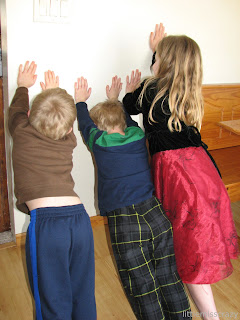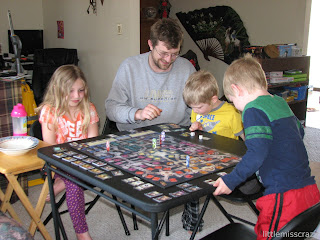I hemmed and hawed about where to start our history studies for a long time. At first, I was planning to jump right into Story of the World and start in on nomads settling on the rivers in the Middle East. Then I thought the kids would appreciate some time to talk about the dinosaurs. Then I realized my kids really care very little for dinosaurs (so little that they were happy to skip them entirely). Finally, I realized that the only thing that made sense was to start at the very beginning.
Now I know not everyone agrees on what that was, how it happened, and how quickly it happened; but since this was meant to be a very brief overview of time (and also give me time to get resources together for our following units), I chose Bible stories to cover our first few weeks into official schooling.
I'm not big on Bible studies. You'll notice that I don't include any religious study in our daily or weekly schooling like many families who homeschool do. And if you knew me at all, you'd know it was a tough decision to claim the Christian timeline and teach it to my children. But in the end, I am very happy with this decision, and I think I did relative justice to my children and the subject at hand.
Week one, we covered the seven days of creation. The kids each made a book with one page for each day, which was really fun. The backgrounds were all made from ripping paper so the kiddoes had a blast doing that. We cut out a few of the harder shapes, and I let them use markers to draw in the most complex additions.
I also read them a variety of other creation myths from different
cultures around the world. We briefly discussed similarities and
differences among the stories. They were really fascinated with some of
the stories, and Athena was able to understand how each tale was based
on facts people knew about their world. She was truly convinced for some
time afterward that the Cherokee myth must be right because it
explained nocturnal animals, and that was an idea she could understand.
Week two, we dedicated to Adam and Eve, and Cain and Abel. This was a difficult week for discussion because the subject of sin is so challenging to pinpoint; I didn't want to oversimplify or overcomplicate it. In the end, they had a pretty good idea of the events and why things unfolded in this way and how this would affect things in the future. Honestly, it was a pretty hard week to get through, and I'm proud that they understood what was covered.
Week three was definitely the most fun of the four because we covered Noah and the ark. We read through the Bible story, and then although it is not very true to the Christian story, I let the kiddoes watch a short Disney cartoon of Noah's ark (
part 1 and
part 2). We discussed the reasons for the flood and the agreements made between Noah and god. For art, the kiddoes painted rainbows, after we talked about the symbolism of rainbows from Noah's story.
Week four, we went over the Tower of Babel. Since I have a couple little builders,we had some fun with the tower (most of the idea originally came from
here). First, we built towers out of wood blocks. I gave each child the same number of blocks to build. No one could make one very big. So I told them to put all their blocks together so they could build a much higher tower. Then I made an earthquake by shaking the table and knocked the tower over. Then I started speaking bits and pieces of other languages (heaven knows, I am not fluent enough in anything to pull off more than a few words here and there). They got confused, but then thought back to the story. They understood how confusing and difficult it would be to stay with people who spoke a different language. Then I showed them the countries and regions of the world where some of the words I had been speaking came from (okay, okay, I did teach them a couple words of Klingon too, but luckily no one asked me to show them that area on the map), and we discussed how people spread all over.
I couldn't resist adding in one more activity. I printed off some bricks from
1+1+1=1, put numbers on them, and had the kids build a tower with them on construction paper-- making sure to glue the blocks on in order. (None of them wound up in order on paper, but they did actually glue them on in numerical order.)
All in all, I think this little diversion into Bible history went well. It made for a lot of fun projects to start our first year off with, and the kids and I were able to get into the spirit of things without pushing too hard.
-- Little Miss Crazy



























